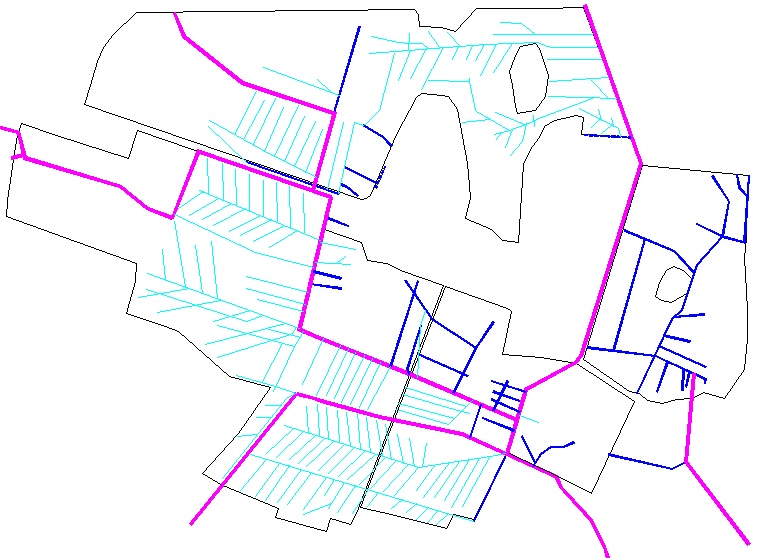Interdisciplinary work:
Where can CDI be implemented?
![]() Controlled Drainage technique is being
used a lot in United States, Canada and in Finland, however for somewhat
different purposes. In the US the focus is on the problem with nitrate in soil
and in groundwater while Baltic region is more focused on making conditions in
the Baltic Sea better. The yearly increasing algal blooming is one evidence
noticed by the public that something is going very wrong in the Baltic Sea. CDI
is one of the solutions that can help to solve problems described above. In
Sweden there are a few farms that have implemented Controlled Drainage
besides Ragnabo Farm in order to deal with the problem. However the CDI
implementation pace needs to be speeded up in Sweden and other countries because the
Baltic Sea is coming closer to a biological collapse, which would be a nightmare
for many people. For the last 50-60 years we have accumulated nutrients into
this sea so that the ecosystem has entered a stable but very unpleasant
condition. Due to the stability and 'inertia' it will take large energy, effort
and time to tip the sea back to its original stable and healthy condition. It
will not get there by its own, unfortunately it is too late for that.
Controlled Drainage technique is being
used a lot in United States, Canada and in Finland, however for somewhat
different purposes. In the US the focus is on the problem with nitrate in soil
and in groundwater while Baltic region is more focused on making conditions in
the Baltic Sea better. The yearly increasing algal blooming is one evidence
noticed by the public that something is going very wrong in the Baltic Sea. CDI
is one of the solutions that can help to solve problems described above. In
Sweden there are a few farms that have implemented Controlled Drainage
besides Ragnabo Farm in order to deal with the problem. However the CDI
implementation pace needs to be speeded up in Sweden and other countries because the
Baltic Sea is coming closer to a biological collapse, which would be a nightmare
for many people. For the last 50-60 years we have accumulated nutrients into
this sea so that the ecosystem has entered a stable but very unpleasant
condition. Due to the stability and 'inertia' it will take large energy, effort
and time to tip the sea back to its original stable and healthy condition. It
will not get there by its own, unfortunately it is too late for that.
Interdisciplinary work:
 It will
require interdisciplinary knowledge and
work across borders of farming, land and water science, oceanography, marine
biology, eco system and fishing but also a political will among countries to
reach goal. It takes a holistic view to see what has to be done. Since the
Baltic Sea is a brackish mediterranean sea it is very vulnerable to excessive
nutrients that are fed into the sea. The work will involve both scientists as
well as practitioners.
It will
require interdisciplinary knowledge and
work across borders of farming, land and water science, oceanography, marine
biology, eco system and fishing but also a political will among countries to
reach goal. It takes a holistic view to see what has to be done. Since the
Baltic Sea is a brackish mediterranean sea it is very vulnerable to excessive
nutrients that are fed into the sea. The work will involve both scientists as
well as practitioners.
Farming Goals:
For the
countries in the Baltic region it is important to find more sustainable farming
and land/water management practices to keep the Baltic Sea as healthy as
possible and the same time be able to feed 90 millions of people in the region.
Many different practices must of course collaborate to reach this goal. Good
drainage systems on arable land are crucial as it both reduces leaching and improves
crop yield and efficiency.
Drainage Infrastructure Information:
 Generally speaking we are in technical debt to coming generations as we have neglected
maintenance of drainage systems in the recent decades. Today we simply do not
keep up the with necessary reconditioning work with the yearly degradation of the
systems. In a long-term perspective this will increase nutrients outflow from arable land.
Another issue is lack of maps and map information. These maps are often lost
between farm owners or between leasehold farmers. In Sweden there is no central
organization that has the responsibility to store and maintain drainage maps and
related info such as the so called
'underground layer'.
Generally speaking we are in technical debt to coming generations as we have neglected
maintenance of drainage systems in the recent decades. Today we simply do not
keep up the with necessary reconditioning work with the yearly degradation of the
systems. In a long-term perspective this will increase nutrients outflow from arable land.
Another issue is lack of maps and map information. These maps are often lost
between farm owners or between leasehold farmers. In Sweden there is no central
organization that has the responsibility to store and maintain drainage maps and
related info such as the so called
'underground layer'.
CDI as three-layered function:
CDI carries 3
functions: Control, Drainage, and Irrigation. When a farmer implements CDI he
goes from 1 degree of freedom to 3 degrees of freedom. The second degree is to
adjust drain level and third degree is control the irrigation. This opens up new
action possibilities for the farmer in adjusting draining and irrigation because
of weather conditions on a daily, weekly or seasonally basis. These new actions
are the keys to counteract nitrogen leaching and also reduce effect on upcoming
climate changes.
Environmental
journey:
From a Ragnabo Farm perspective the environmental journey started in
2004 with the 2 year project Ragnabo Dämme (Ragnabo Dam). A modification to the
existing drainage system was made and the effective CDI area became about 5-6
ha. The project continued in the following years reported in (as pdf):
Environmental
Project on Ragnabo Farm. The CDI area is today about 24 ha (60% of arable land)
and 18 drainage and irrigation controllers are implemented in a semi-automatic
distributed network.